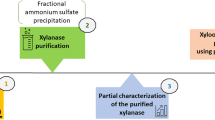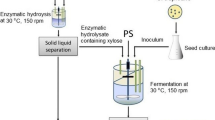Abstract
Xylitol, a five-carbon sugar alcohol, is a valuable sugar substitute, and widely used in the pharmaceutical, odontological and food industry due to its interesting properties. In the past decades, the xylitol industry has grown rapidly and more attention has been focused on xylitol purification, which possesses an important proportion of the whole industry. In our paper, the purification and crystallization of xylitol fermentation broth by biotechnology using corncob hydrolysates as substance were studied. An initial xylitol fermentation broth was decolored with activated carbon (1% M−1, 60°C, 165 rpm), desalted with a combination of two ionexchange resins (732 and D301), and residual sugars were separated with UBK-555(Ca2+). Then the solution was vacuum-concentrated up to supersaturation (750 g/L xylitol). After adding 1% xylitol crystal seeds, the supersaturated solution was cooled to −20°C for 48 h. The crystalline xylitol of a regular tetrahedral shape with purity 95% and crystallization yield 60.2% was obtained from the clarified xylitol fermentation broth. An intact, economical and environmental-friendly route of purification and crystallization of xylitol from fermentation of corncob hydrolysates was obtained, and its experimental procedure and data provided a sound basis for large-scale industrial production.
Similar content being viewed by others
References
Ylikahri R. Metabolic and nutritional aspects of xylitol. Adv Food Res, 1979, 25: 159–180
Mäkinen K K, Chiego D J, Allen P, Bennet C, Isotupa K P, Tiesko J, Makinen P L. Physical, chemical and histological changes in dentin caries lesion of primary teeth induced by regular use of polyol chewing-gums. Acta Odontol Scand, 1998, 56: 148–156
Miyasawa H I Y, Mayanagi H, Takahashi N. Xylitol inhibition of anaerobic acid production by streptococcus mutans at various pH levels. Oral Microbiol Immunol, 2003, 18: 215–219
Mäkinen K K, Söderling E. A quantitative study of mannitol, sorbitol, xylitol, and xylose in wild berries and commercial fruits. J Food Sci, 1980, 45: 367–371
Jeffries T W, Kurtzman C P. Taxonomy of xylose-fermenting yeasts. Enzyme Microb Technol, 1994, 6: 922–932
Vandeska E, Kuzmanova S, Jeffries T W. Xylitol formation and key enzyme activities in Candida boidinii under different oxygen transfer rates. J Ferment Bioeng, 1995, 80: 513–516
Rivas B, Domínguez J M, Domínguez H, Parajó J C. Bioconversion of post-hydrolyzed autohydrolysis liquors: an alternative for xylitol production from corncobs. Enzyme Microb Technol, 2002, 31: 431–438
Liaw W C, Chen C S, Wen S C, Kuan P C. Xylitol production from rice straw hemicellulose hydrolyzate by polyacrylic hydrogel thin films with immobilized Candida subtropicalis WF79. J Biosci Bioeng, 2008, 105: 97–105
Converti A, Domínguez J M, Perego P, Silva S S, Zilli M. Wood hydrolysis and hydrolysate detoxification for subsequent xylitol production. Chem Eng Technol, 2000, 23: 1013–1020
Eleonora W, Slobodanka K. Microbial conversion of D-xylose to xylitol. J Ferment Bioeng, 1998, 86: 1–14
Faveri D, Torre P, Perego P, Converti A. Xylitol recovery by crystallization from synthetic solutions and fermented hemicellulose hydrolysates. Chem Eng J, 2002, 90: 291–298
Faveri D, Torre P, Perego P, Converti A. Optimization of xylitol recovery by crystallization from synthetic solutions using response surface methodology. J Food Eng, 2004, 61: 407–412
Gurgel P V, Mancilha I M, Peçanha R P, Siqueira J F M. Xylitol recovery from fermented sugarcane bagasse hydrolyzate. Biores Technol, 1995, 52: 219–223
Martínez E A, Silva A J B, Giulietti M, Solenzal A I N. Downstream process for xylitol produced from fermented hydrolysate. Enzyme Microb Technol, 2007, 40: 1185–1189
Parajo J C, Dominguez H, Dominguez J M. Improved xylitol production with Debahansenii Y-7426 from raw or detoxified wood hydrolysates. Enryme Microb Technol, 1997, 21: 18–24
Chen L F, Gong C S. Fermentation broth of sugarcane bagasse hemicellulose hydrolysate to xylitol by a hydrolysate-acclimatized yeast. J Food Sci, 1985, 50: 227
Jandera P, Churacek J. Ion-exchange chromatography of aldehydes, ketones, ethers, alcohols, polyols and saccharides. J Chromatogr, 1974, 98: 55–104
Vyglazov V V, Kholĭkin Y I. Solubility in the system xylitolethanol-water and certain properties of saturated solutions. Zurnal Prikladnoi Khimii, 1984, 57: 1651–1654
Martínez E A, Giulietti M, Almeida S J B, Solenzal A I N, Derenzo S. Estudio de lacinética de cristalización del xilitol. Efecto de la velocidad de enfriamiento Ing Quím, 2005, 37: 88–96
Giulietti M, Seckler MM, Derenzo S, Ré MI, Cekinski E. Industrial crystallization and precipitation from solutions: state of the technique. Braz J Chem Eng, 2001, 18: 423–440
Mussato S I, Roberto I C. Hydrolysate detoxification with activated charcoal for xylitol production by Candida guilliermondii. Biotechnol Lett, 2001, 23: 1681–1684
Lee W G, Lee J S, Shin C S, Park S C, Chang H N, Chang Y K. Ethanol production using concentration oak wood hydrolysates and methods to detoxify. Appl Biochem Biotechnol, 1999, 77: 547–559
Author information
Authors and Affiliations
Corresponding author
Rights and permissions
About this article
Cite this article
Wei, J., Yuan, Q., Wang, T. et al. Purification and crystallization of xylitol from fermentation broth of corncob hydrolysates. Front. Chem. Eng. China 4, 57–64 (2010). https://doi.org/10.1007/s11705-009-0295-1
Received:
Accepted:
Published:
Issue Date:
DOI: https://doi.org/10.1007/s11705-009-0295-1




